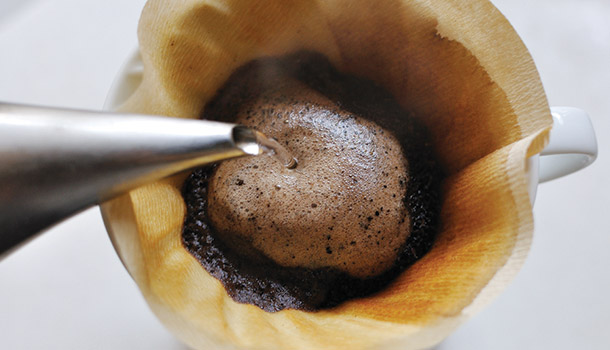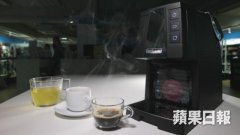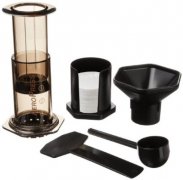[Hand Drip] handmade coffee accessories-- A little knowledge of filter cups
For professional baristas, please follow the coffee workshop (Wechat official account cafe_style)

1. Filter cup: the bottom drilled filter cup containing filter paper and ground coffee powder, placed on the coffee pot.
two。 Groove line (lib): the wrinkled vertical groove on the inside of the filter cup, coffee liquid extraction will be used as a gas convection channel, but also facilitate the flow of liquid, at the same time, after the extraction, it is easier to remove filter paper. The more grooves, the faster the liquid flows.
3. Extraction hole: a small hole at the bottom of the filter cup through which coffee is extracted.
4. Coffee pot: a glass container that holds coffee liquid and is placed under the filter cup.
5. Slender kettle: a modified kettle for drip-filter hand-brewed coffee, characterized by a narrower and longer outlet than an ordinary kettle, which is specially designed to maintain a slender column of water at a certain speed.
6. Coffee filter paper: used to filter coffee powder, depending on the filter cup manufacturer, the appearance and folding method are also different.

The history of hand-punching filter cup
Melitta (Melita)
In general people's understanding, hand-brewing coffee requires meticulous skills, so many people think that hand-brewing coffee originated in Japan. Actually, it started in Germany. Ms. Melitta Bentz, who lives in Dresden, Germany, uses the paper from her son's workbook as filter paper and filters the coffee powder residue in a drilled copper bowl to extract coffee. There is no doubt that using paper to filter coffee powder was of epoch-making significance at that time. Compared with filtering with pieces of cloth or rags in the past, filtering with paper has less miscellaneous smell and cleaner taste. So Ms. Merita founded Melitta in 1908 and began producing improved filter cups and filter paper. The filter cup style invented by Melita in 1937 has become the prototype of the filter cup as we know it today.
Calita (Kalita)
In many cases, coffee utensils invented in the West do not blossom until they cross the sea to Japan, and the hand dripping filter pot is one of them. In 1959, about 50 years after Melita's invention, the manual drip filter kit developed by Kalita of Japan was put on the market. Because the name Kalita is so similar to Melita, the ancestor of the hand drip filter, it is even suspected to be a copycat version of Melita in Japan. Kalita's contribution is to popularize the culture of hand-made coffee all over Japan, and Kalita has also become the representative brand of hand-drip filter pot, even to the extent that "hand-drip filter pot = Kalita".
Kano (KONO)
In 1925, Konobin founded KONO, which specializes in siphon pots. After long-term research, the company launched the "KONO filter Cup Meimon" and "KONO hand filter Cup" in 1973, which are different from the existing hand filter methods, leading the hand filter cup to the advanced level. In fact, using KONO filter cup to extract coffee by KONO drip filtration is the most difficult and time-consuming. But its proud multi-layer consistency also makes many coffee experts believe that cafes that use KONO-style trickling filtration are the most professional cafes.
Harrio (Hario)
Known as the "Glass Emperor", Hario, founded in 1921, is a Japanese brand specializing in the manufacture of glass, producing a variety of products from household products to industrial ∕ medical supplies with high-quality heat-resistant glass. Representative coffee makers include V60, siphon kettle, curling kettle and so on. V60, which means 60-degree angle V-shaped filter cup, was first put on the market in October 2005. the advantages of heat resistance and temperature difference, coupled with the characteristics of heat-resistant glass without peculiar smell and color, have become the most suitable apparatus for brewing high-quality coffee.
Hand filter cup short story ─ filter paper is very scientific
Filter paper is generally divided into bleached white filter paper and brown filter paper using natural pulp. Compared with brown filter paper, the bleached white filter paper has less pulp flavor and purer coffee flavor, but the chlorine used in bleaching will cause environmental pollution. Recently, well-known manufacturers have begun to improve filter paper. in addition to using oxygen, non-fluorescent and other environmentally friendly bleaching methods, bleaching filter paper has also been converted to various advanced materials such as bamboo and coniferous fiber.
Good filter paper is usually very thick, the fiber tissue is denser, not only can flow through without hindrance, but also can highly filter unnecessary impurities, but the price of this filter paper is quite high, more than 0.5 yuan per piece.

Get rid of the obsessive-compulsive disorder of fine water column
When it comes to hand-brewing coffee, the first thing that comes to mind is a long, thin column of water, so many people try very hard to control the flow of water when making coffee by hand, so they have to keep it long and thin. But in fact, the water column needed to make coffee by hand should be thicker. The barista of the Japanese company Kalita, who has demonstrated hand-brewing coffee, said that what surprised him most was that many people deliberately made the water column too fine, even thinner than needed. This is also the focus of Kalita's demonstration coffee every year. Hand-brewed coffee requires a fine column of water to some extent, but the concept of "having to be a fine column of water" is not very healthy.
Is there a "hamburger" in the steaming?
One of the best moments of hand-brewing coffee is the steaming process in which the coffee powder begins to come into contact with water to discharge gas and expand. This is also one of the moments with the strongest aroma of coffee. The phenomenon of coffee powder volume expansion is called "powder layer development", or "hamburger", which creates visual stimulation and enjoyment. However, there are often cases where the powder layer does not expand when making coffee by hand, so it is necessary to confirm the following points:
Freshness: if you brew coffee with stale coffee beans, there will be no "hamburgers". By the same token, it is rare for coffee powder to expand when hand-brewing coffee is stored after grinding.
Water column: the water column is too thick, and if the amount of water exceeds the appropriate level of coffee powder, it will penetrate. In this way, it is naturally impossible to cause expansion, and the coffee powder layer will sink in instead.
Coffee bean quantity: the bean quantity is too small, cannot accumulate the proper thickness and the density, cannot expand naturally.
Reasonable watering method
"what kind of pot is this? it's so expensive? "people who want to buy a whole set of hand-brewed coffee utensils will complain about it. For a Pour over filter cup, it is not necessary to use a fine pot when injecting water. In the United States, the original meaning of "Pour over" is "watering, dumping". In other words, when making coffee by hand, you don't need to use a small kettle seriously. You can use a kettle at will. When using an electric kettle or an ordinary kettle, steaming may be a little difficult, but as long as you practice a few more times, if you get home with kung fu, you can also control a column of water with a certain thickness.
We can regard the flow size of pouring as a means to control the change of water volume and extraction time. As long as a stable extraction can be achieved, it is not necessarily entangled in the thickness of the water column.
Article source: "A brief history of household coffee utensils, guidelines for brewing and maintenance"
Important Notice :
前街咖啡 FrontStreet Coffee has moved to new addredd:
FrontStreet Coffee Address: 315,Donghua East Road,GuangZhou
Tel:020 38364473
- Prev

[Super convenient] three knives of the head-changing coffee machine drink 90% of the capsule coffee on the market.
For professional baristas, please follow the coffee workshop (Wechat official account cafe_style) Trent Steele HQ101 compatible coffee maker with a variety of powder sacs for $1479. The capsule coffee maker does bring a lot of convenience to coffee lovers! Apart from sighing high-quality coffee, it also has the convenience of instant coffee, but there is a small problem, that is, the coffee glue introduced by different coffee companies.
- Next

American coffee master AeroPress Philharmonic pressure positive pressure coffee operation course
Aerobie AeroPress is a single cup coffee brewing system that will provide excellent use on the road and even as a solution for high-quality office coffee. The price of the system is between $25 and $30, which I think is reasonable. In addition to the core brewing system, you can also get 350 AeroPress filters and one holder. This equipment is equipped with several other coffee brewing methods.
Related
- What is the Philharmonic pressure? How to use Philharmonic pressure to make delicious coffee
- Why does a hand grinder have more fine powder than an electric grinder?
- In addition to the hot mom, what is the difference between the versions of EK43 | ditting and Mahdi ek43?
- What kind of equipment do you need to make coffee by hand? Introduction to novice starter cooking equipment tools
- Espresso needs to be ground how thick and thin scale entry Italian Coffee Machine Bean Grinder investigation and Grinding course
- How much does it cost to open a small private cafe? How much does it cost to learn coffee? How to operate it?
- The difference between the flavor characteristics of hand-brewed coffee and coffee maker is hand-brewed coffee really better than coffee maker? Can I use a coffee machine to make coffee beans by hand?
- The difference between 01 and 02 of hario v60 filter cup what is the difference between 01 and 02 filter cup opening and cooking flavor
- What's the difference between the smart cup and the French kettle? Which is better, the French kettle or the Smart Cup?
- What's the difference between a smart cup and a V60 filter cup? The difference between the taste of smart cup and hand-brewed coffee

